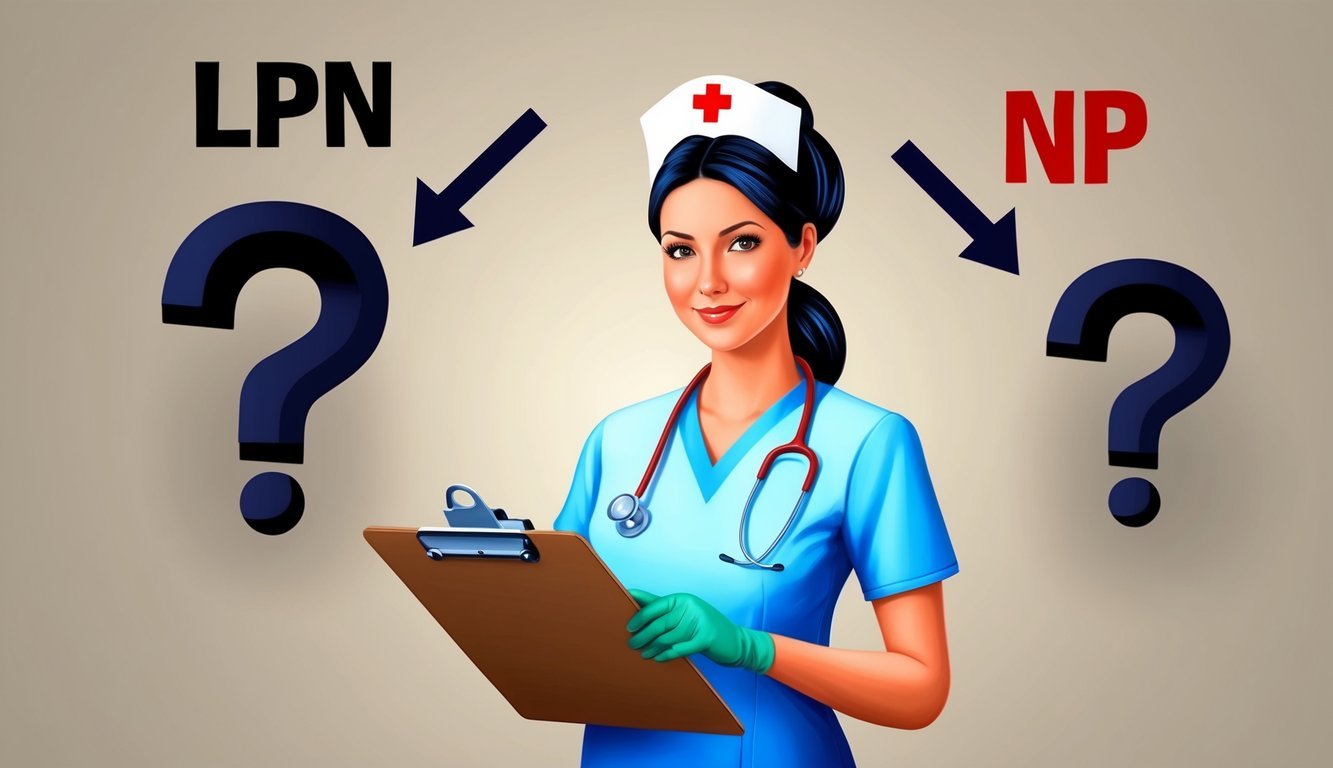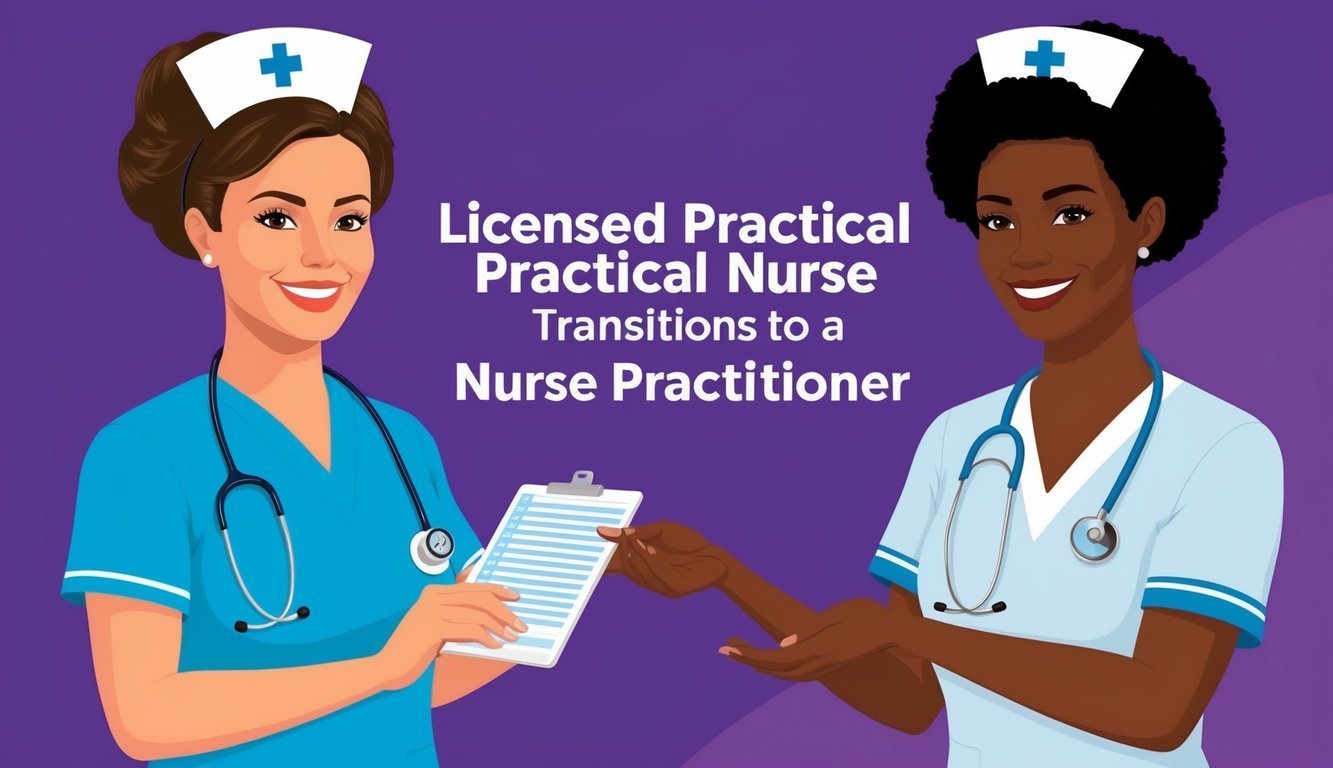Transitioning from a Licensed Practical Nurse (LPN) to a Nurse Practitioner (NP) can be a rewarding path for those looking to enhance their careers in healthcare.
This journey involves further education, obtaining advanced certifications, and gaining a deeper understanding of patient care.
As an NP, you will have the autonomy to diagnose and treat patients, making a significant impact on their health and well-being.
Many healthcare providers consider the role of Nurse Practitioners essential for filling gaps in patient care.
To become an NP, you must first become a Registered Nurse (RN) and acquire the necessary degrees, such as a Bachelor of Science in Nursing (BSN) and a master’s or doctoral degree focused on nursing practice.
This path not only opens up new career opportunities but also allows you to partake in advanced practice settings that require higher levels of expertise.
Understanding the steps involved in this transition can make the process smoother and more manageable.
You can explore various educational programs and resources that cater to your specific situation, supporting your move from LPN to NP.
Key Takeaways
- Becoming a Nurse Practitioner involves further education and certification beyond being an LPN.
- Nurse Practitioners play a vital role in delivering comprehensive healthcare services.
- Advancing to NP offers numerous career opportunities and enhances your ability to impact patient care.
Understanding the LPN and NP Roles

The roles of Licensed Practical Nurses (LPNs) and Nurse Practitioners (NPs) differ significantly in scope, education, and career outlook.
It is important to understand these distinctions as you consider advancing your career in nursing.
Scope of Practice and Responsibility
LPNs perform basic nursing tasks under the supervision of Registered Nurses (RNs) or doctors.
Their duties include administering medication, taking vital signs, and assisting with daily activities for patients.
LPNs have a limited scope of practice and usually work in settings like nursing homes or clinics.
In contrast, Nurse Practitioners hold advanced degrees and can diagnose and treat medical conditions independently.
NPs can prescribe medications and provide a high level of patient care.
Their responsibilities may include conducting physical exams, developing treatment plans, and managing patient care.
Understanding the scope of practice for each role helps clarify the level of responsibility you can expect.
Educational Paths and Licensure
The path to becoming an LPN typically involves completing a one-year accredited program, followed by passing the NCLEX-PN exam.
This pathway focuses on basic nursing skills and clinical experience.
For NPs, the educational route is more extensive.
You must first obtain a Bachelor of Science in Nursing (BSN), followed by a Master of Science in Nursing (MSN) or a Doctor of Nursing Practice (DNP) degree.
You also need to pass the NCLEX-RN exam to become a Registered Nurse before specializing as an NP.
Each pathway requires dedication and commitment to different levels of education and training.
Career Progression and Job Growth
According to the Bureau of Labor Statistics, job growth for LPNs is projected at 9% from 2020 to 2030, which aligns with the growing demand for healthcare services.
LPNs may find opportunities to advance by earning higher qualifications or specializing in specific areas.
Nurse Practitioners, on the other hand, will experience significant job growth, estimated at 45% over the same period.
This surge is due to the rising need for healthcare providers who can manage patient care effectively.
Both roles offer unique opportunities, but NPs have a broader scope and more potential for career advancement.
Educational Requirements for Transition

Transitioning from an LPN to an NP involves several educational steps.
You need to first become a registered nurse (RN) and then pursue advanced nursing degrees.
Specialized training is also essential to enhance your skills.
From LPN to RN
To move from LPN to RN, you must earn either an Associate Degree in Nursing (ADN) or a Bachelor of Science in Nursing (BSN).
An ADN typically takes about two years, while a BSN usually requires four years of study.
If you choose the ADN path, you can often complete a bridge program that allows you to enter the RN field more efficiently.
After obtaining your degree, you must pass the NCLEX-RN exam to become licensed.
This is a crucial step to ensure you meet the competency requirements for registered nursing.
Advanced Nursing Degrees
Once you are an RN, the next step is to pursue advanced nursing degrees, like a Master of Science in Nursing (MSN) or a Doctor of Nursing Practice (DNP).
The MSN program focuses on advanced clinical skills and theoretical knowledge necessary for nurse practitioners.
This degree typically requires 1-2 years of study, including extensive clinical training.
The DNP, which is more research-oriented, can take an additional 1-3 years.
For both degrees, you will engage in specific coursework related to advanced practice roles, healthcare policy, and leadership in nursing.
Specializations in Nursing
As you advance in your education, you may also choose to specialize in a certain area of nursing.
Specializations can include family practice, pediatrics, or gerontology, among others.
Each specialization requires targeted training and specific clinical experiences.
This training often occurs during your MSN program or after completing your DNP.
Completing a specialization not only enhances your skills but also makes you more competitive in the job market.
Many programs will support you in pursuing certification in your chosen specialty to ensure you meet the necessary standards.
The Role of Nurse Practitioners in Healthcare

Nurse practitioners (NPs) play a vital role in the healthcare system by offering comprehensive patient care, including primary and specialized services.
They focus on health promotion, disease prevention, and treatment plans tailored to each patient’s needs.
Primary Care and Specialized Care
As a nurse practitioner, you provide access to both primary and specialized care.
In primary care, you manage a variety of health concerns, from routine check-ups to chronic disease management.
Your training allows you to treat common illnesses, conduct health assessments, and provide ongoing support.
In specialized care, you may focus on areas like pediatrics, geriatrics, or mental health.
This specialized knowledge helps you offer targeted treatment plans and interventions.
NPs work in diverse settings such as hospitals, clinics, and private practices, ensuring patients receive quality care regardless of their health challenges.
You are an essential member of the healthcare team who collaborates with doctors and other health professionals.
Preventive Care and Treatment Plans
Your role involves significant emphasis on preventive care, which is crucial to reducing the incidence of diseases.
You educate patients about healthy lifestyle choices, such as diet and exercise.
By promoting these practices, you help patients avoid health issues before they arise.
When patients do require treatment, you develop custom treatment plans.
These plans take into account medical history, lifestyle choices, and individual needs.
By regularly monitoring progress, you can adjust these plans as necessary to ensure the best outcomes.
Education on managing conditions and recognizing warning signs is also a key part of your duties.
Prescribing Medications and Ordering Diagnostic Tests
One of your essential functions as a nurse practitioner is the ability to prescribe medications.
You assess patient needs and create medication plans that align with established treatment goals.
Your training enables you to choose appropriate medications while considering potential side effects and interactions.
You also have the authority to order diagnostic tests.
This allows you to gather important information about patient health more efficiently.
Common tests may include blood tests, X-rays, or imaging studies.
By interpreting these results, you can make informed decisions about patient care and treatment strategies, ensuring comprehensive and effective health management.
Licensing and Practice Authority
Understanding the licensing requirements and practice authority for nurse practitioners is essential for your career transition from LPN to NP.
This section provides an overview of the necessary examinations, variations in practice authority across states, and the importance of continuing education.
National Council Licensure Examination (NCLEX)
To become a registered nurse (RN), you must pass the NCLEX-RN Exam.
This exam tests your knowledge and skills critical for safe nursing practice.
As a current LPN, your experience will be beneficial, but the NCLEX-RN covers broader topics, including:
- Safe and Effective Care Environment
- Health Promotion and Maintenance
- Psychosocial Integrity
- Physiological Integrity
Once you pass the NCLEX-RN, you obtain your RN license, a crucial step before pursuing your NP education and certification.
It’s important to ensure you meet the eligibility requirements for your state before applying to take the exam.
NP Practice Authority Variations
NP practice authority varies significantly by state.
Understanding these differences is crucial.
States generally fall into three categories regarding NP authority:
| Practice Type | Description |
|---|---|
| Full Practice | NPs can evaluate patients, make diagnoses, interpret diagnostic tests, and initiate treatment plans independently. |
| Reduced Practice | NPs can perform most tasks but require a supervisory or collaborative agreement with a physician. |
| Restricted Practice | NPs have limited ability to practice and must work under a supervising physician’s authority. |
For example, in 2024, states like Utah and 29 others allow full practice authority, whereas some states maintain restrictive practices.
Always research your state’s regulations at resources like AANP to understand your options.
Continuing Education and Certification
Continuing education is essential for maintaining your NP certification.
Once you become an Advanced Practice Registered Nurse (APRN), most states require ongoing education to stay current with medical practices.
- You may need to complete 30-50 hours of continuing education every two years.
- Specific topics may include pharmacology, clinical practice updates, or patient management.
Additionally, national certification from organizations like the American Association of Nurse Practitioners (AANP) or the American Nurses Credentialing Center (ANCC) is often required.
Earning and maintaining certification helps you expand your knowledge and improve your job prospects.
Pursuing these steps ensures you are well-prepared for your responsibilities as a nurse practitioner.
Career Opportunities and Advancement

Transitioning from an LPN to an NP opens a range of career opportunities in various healthcare settings.
You can pursue specialized roles, expand your responsibilities, and enhance your earning potential.
This progression requires education and experience, which can significantly impact your career path.
Employment Settings and Roles
As a nurse practitioner, you can work in diverse settings, including hospitals, clinics, and private practices.
Common roles include family nurse practitioner, pediatric nurse practitioner, and psychiatric mental health nurse practitioner.
Common Employment Settings:
| Setting | Key Roles |
|---|---|
| Hospitals | Acute care, specialty care |
| Clinics | Community health, outpatient services |
| Private Practices | Family care, specialty care |
| Schools | School health services |
| Telehealth | Remote patient care |
You may collaborate with other healthcare professionals, such as physicians and pharmacists, to provide comprehensive care.
Advancement through Education and Experience
Continuing education is vital for your career advancement.
A common path is pursuing a Master of Science in Nursing (MSN).
This program typically includes coursework in advanced practice nursing, pharmacology, and health assessment.
Gaining clinical experience through internships or residencies will further enhance your skills.
Many states require certification and licensure for NPs, so completing an accredited program is crucial.
You might also explore further specializations through continuing education programs.
These programs can offer advanced knowledge in areas such as gerontology or women’s health.
The Future of Nursing Careers
The demand for nurse practitioners is expected to grow due to an aging population and an increased focus on preventive care.
According to the U.S. Bureau of Labor Statistics, job opportunities for NPs are projected to increase significantly in the coming years.
This expansion may lead to more roles in emerging fields, such as telehealth and healthcare technology.
As an NP, you will likely find opportunities to lead initiatives and improve patient care practices, positioning you as a vital member of the healthcare team.
Staying current with trends and pursuing certifications will enhance your career prospects and professional development.
Frequently Asked Questions

When considering the path from LPN to NP, you might have several important questions about education, time commitment, salary, and available programs.
Here are key details to help you understand the transition.
What are the educational requirements for an LPN to become a Nurse Practitioner?
To become a Nurse Practitioner, you need at least a Bachelor of Science in Nursing (BSN) or a Master of Science in Nursing (MSN).
If you hold a non-nursing bachelor’s degree, you may qualify for accelerated programs.
Completing an accredited nursing program is essential for obtaining your NP license.
How long does it typically take to transition from an LPN to an NP?
The transition time varies based on your chosen path.
If you enroll in an accelerated BSN program, it may take about 12 to 18 months.
Once you have your BSN, pursuing an MSN can take an additional 2 to 3 years.
This makes the total transition time approximately 3 to 4 years, depending on your situation.
Can an LPN enroll directly in a Nurse Practitioner program?
Generally, you cannot enroll directly in an NP program as an LPN.
You typically need to first become a registered nurse (RN) by completing a BSN or an Associate Degree in Nursing (ADN).
After obtaining your RN license, you can then apply for an NP program.
What is the salary difference between an LPN and an NP?
The salary difference is significant.
As an LPN, you can expect to earn an average salary of about $48,000 per year.
In contrast, Nurse Practitioners earn an average salary of around $110,000 annually.
This difference reflects the advanced training and responsibilities of NPs.
Are there online programs available for LPNs to become Nurse Practitioners?
Yes, there are many online programs designed for LPNs.
These programs typically offer flexible schedules to accommodate your work and personal life.
Online study combined with clinical practice makes it easier to balance your responsibilities while advancing your education.
What steps are involved in transitioning from LPN to MSN for aspiring Nurse Practitioners?
The path from LPN to MSN involves several key steps:
- Become an RN: You need to complete an ADN or BSN program to obtain your RN license.
- Gain Experience: After that, you should work as an RN to gain the necessary clinical experience.
- Apply to MSN Program: Then, research and apply to accredited MSN programs designed for RNs.
- Complete Coursework: Once you’re accepted, make sure to finish required courses and clinical rotations.
- Obtain NP License: Finally, you need to pass the national certification exam for Nurse Practitioners.

